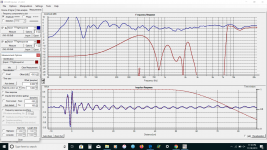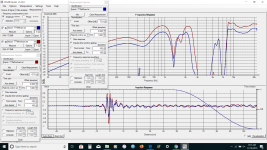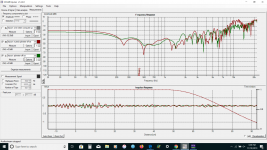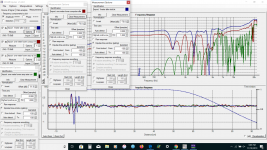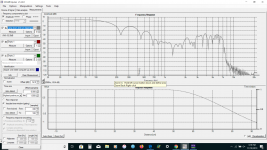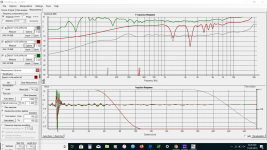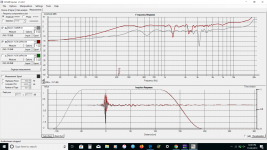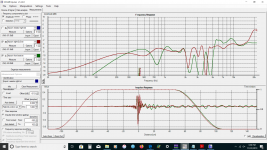according to my multimeter all of my resistors and caps are bad even the brand new ones in the bag. so I have ordered a new multimeter. I am having trouble getting the REW files to import into holms everything was working fine then a couple of days ago they wont load and they crash the program I have removed redownloaded and reinstalled all of the programs but it is not working. It will import the older files weird.
Guessing you are using the resistance scales .... Touch your meter leads together, you will get some value of resistance that is the resistance of the leads themselves... from there you need to subtract that amount from each reading on low valued parts.
i think the meter is bad it is only a couple of years old. but I opted foolishly for an amazon special and got what I deserve. 50.00 wasted. It is acting very strange the ohms go to 0 when a resistor or the leads are touched all caps are ol and the continuity beeps even when the leads are not touching. the stupid light still works yeah. I will have a meter on Thursday but have to get my eye peeled on Thursday so may be a few days off the speakers. got holms working again thank you all. i am getting a fairly flat raw FR but gated is terrible. this is 2 meters and off axis. as soon as I get the meter I will I will clean the PCB and check for shorts measure straight on.
Attachments
Now your measurement has something going on at 8kHz. You aren't having much luck with consistency. It may be affecting even your good looking measurements, not too certain about that.
I'm thinking there's something intermittent. Like you previously described. The Primaire again? Is your sound card able to drive a speaker directly, they can deal with headphones..
How do you feel about tracking this down. Do you want some suggestions?
I'm thinking there's something intermittent. Like you previously described. The Primaire again? Is your sound card able to drive a speaker directly, they can deal with headphones..
How do you feel about tracking this down. Do you want some suggestions?
Hi Allen I would like to track the issues down. I do not know if any of this matters but here is some information.
It is still the Marantz 1060 but that is almost 50 years old. The measurements above are at 2 meters and off axis - I did measure these on the floor and off the milk crate - I also cleaned the room and moved a portable air conditioner I repaired out of the main area. I tightened the speakers into the cabinet. The speakers are on the floor and may be rocking? I put foam pads under them and got slightly different readings the foam pads are like a carpet pad so they still may be rocking slightly altho the measurements were taken at low volume. I attached the foam and no foam underneath the speaker charts and offset the reading so you can see the impact.
It is still the Marantz 1060 but that is almost 50 years old. The measurements above are at 2 meters and off axis - I did measure these on the floor and off the milk crate - I also cleaned the room and moved a portable air conditioner I repaired out of the main area. I tightened the speakers into the cabinet. The speakers are on the floor and may be rocking? I put foam pads under them and got slightly different readings the foam pads are like a carpet pad so they still may be rocking slightly altho the measurements were taken at low volume. I attached the foam and no foam underneath the speaker charts and offset the reading so you can see the impact.
Attachments
It's almost at though the impulse creates a condition of instability in the amp and it rings at 8k after the impulse. It's more likely to be a response issue, but where. That's a place where things are happening on the plot so it's a little uncomfortable.
Ok. So take a measurement where this happens. Now, reduce the computer output level by 10 or 20dB and see whether that cures it. If not, put that volume back up and turn down the amp by 10 to 20dB. If that doesn't work, turn the amp right down, leave the computer turned up and see. If not, mute the output, if not, disconnect the mic.
Yes, those last ones by rights you shouldn't be getting any input, but if there's a little crosstalk and if it can reveal anything then it's worth a try.
Ok. So take a measurement where this happens. Now, reduce the computer output level by 10 or 20dB and see whether that cures it. If not, put that volume back up and turn down the amp by 10 to 20dB. If that doesn't work, turn the amp right down, leave the computer turned up and see. If not, mute the output, if not, disconnect the mic.
Yes, those last ones by rights you shouldn't be getting any input, but if there's a little crosstalk and if it can reveal anything then it's worth a try.
Last edited:
Hi Allen, I only had a few minutes to work on this and it may be difficult to work on this the rest of this week and part of next. the Mac is a digital out and is toslink so I do not have volume control on the output I only have volume control on the input.
there is some odd things happening first let me explain the chart. the blue line is a one meter measurement. the red line is the computer input turned down -9db the green line is the computer input turned up and the amp turned down the woofers never came on best I can tell there is a forth reading on a separate chart that shows the computer up and amp turned down I could not hear the sweep but this showed up on the screen. I have had several times where only the tweeter would measure. If you want to wait until I can rerun these that may be best as I was very hurried on these measurements
The last chart is the spl meter off and the preamp on mute and the spl meter off and the preamp on I am completely lost.
there is some odd things happening first let me explain the chart. the blue line is a one meter measurement. the red line is the computer input turned down -9db the green line is the computer input turned up and the amp turned down the woofers never came on best I can tell there is a forth reading on a separate chart that shows the computer up and amp turned down I could not hear the sweep but this showed up on the screen. I have had several times where only the tweeter would measure. If you want to wait until I can rerun these that may be best as I was very hurried on these measurements
The last chart is the spl meter off and the preamp on mute and the spl meter off and the preamp on I am completely lost.
Attachments
Last edited:
the last message cut me off during the edit so the chart in the last message is with the spl meter off. here are the charts for the last message.
Attachments
Last edited:
I notice you have REW open. Is the generator turned on? Close REW and see if that helps because some apps want exclusive use of a jack and others may share it.
Also use REW to take the measurements and compare.
Thirdly, (or first if you read this far) check your windows mixer settings for sound card enhancements, like loudness control etc., disable all.
Also use REW to take the measurements and compare.
Thirdly, (or first if you read this far) check your windows mixer settings for sound card enhancements, like loudness control etc., disable all.
Hi Allen - I think you may have found the issue. Bit perfect was running in the background of the mac. Attached is the chart with the raw data (green) the program generated gating (red) and the best looking gating (grey) Believe me I read every word you are sending most of the time several times - and I appreciate your help very much.
I am still using the mac and REW for measurements and transferring them.
I have not figured out how to get the windows computer to work with the single input output jack even with the usb thumb soundcard. If you think running directly into Holms is needed I can put windows on the mac.
thank you again
Ben
I am still using the mac and REW for measurements and transferring them.
I have not figured out how to get the windows computer to work with the single input output jack even with the usb thumb soundcard. If you think running directly into Holms is needed I can put windows on the mac.
thank you again
Ben
Attachments
It's moments like this that make a person feel they can get down to business. I mean, the first thing I noticed when I looked at these is what R2, R3 and C4 were doing 😉
thank you Allen. As soon as I can and I get the meter. I will check out the components and clean up the pcb and the excessive solder and reinstall them R2 is still in but R3 and C4 have been removed. I will be out for the at least the next few days but I really appreciate your help
Attachments
I wish it were so - out of town eye surgery - a shiny new lens but with a follow up visit on Friday will be gone a couple of days. no lifting for a week. thank you again Allen.
I changed out r2 2.2ohm resistor for R3 12 ohm resistor the green line is before the change and the other two lines are raw and gated after the change.
the original r2 was a 20w mundorf supreme that looks like a tube and the new new r2 former r3 is a wirewound greenie. will that effect the sound or should it be a better resistor for some other reason? Will the larger resistor do other unexpected things to the crossover? there seems to be a more pronounced dip with the new resistor. I still have c4 and r3 out.
the original r2 was a 20w mundorf supreme that looks like a tube and the new new r2 former r3 is a wirewound greenie. will that effect the sound or should it be a better resistor for some other reason? Will the larger resistor do other unexpected things to the crossover? there seems to be a more pronounced dip with the new resistor. I still have c4 and r3 out.
Attachments
Hi 8, it would seem you can see, excellent.
Choosing the right type of component can be very important in radio frequency applications, harsh/hot environments, power supplies, low noise applications and such. At audio frequencies with finite impedances we have more relaxed options.
An L-pad is one way to get attenuation without (too significantly) altering the load on the filter.
Choosing the right type of component can be very important in radio frequency applications, harsh/hot environments, power supplies, low noise applications and such. At audio frequencies with finite impedances we have more relaxed options.
It will alter the damping of the high pass. I'm not implying this will be bad or good, but since it is different, and if it was working before...Will the larger resistor do other unexpected things to the crossover?
An L-pad is one way to get attenuation without (too significantly) altering the load on the filter.
It can be difficult to extract surety through measurements that are not clean, but what you describe sounds like the result of a change in phase. You've changed the axial response by the shown amount, and the sound power by an uncertain (but could be measured) amount.there seems to be a more pronounced dip with the new resistor.
Hi Allen thank you,
the eye surgery was downright weird they keep you awake while they put the new lens in. I can see almost as well as before the surgery and they say it will get better over the next month. Still no lifting 10lb limit.
when you say the damping of the high pass do you mean lowering the FR of the tweeter?
I was thinking about the L-pad but when I enter it in xsim it looks like the 12 ohm resister in parallel raises the FR, so a much smaller resistor may be the ticket. returning the 2.2ohm to R2 and a smaller resistor (1ohm) to R3. that may have less effect on the load than the big resistor in R2? the capacitor seems to raise the mid treble with the larger resistor and negate the smaller resistor so that may not be the best thing unless it is there for other reasons. Because shipping is generally expensive I would like to get a list of components rather than order a few at a time. I will buy the better resistors when I do order.
I am confused about phase and polarity. the crossover schematic calls out normal polarity but I have always had to invert the tweeter even with the thors. I have read a few articles on and will continue to do some homework on it.
is that why the imaging outside of the speakers has changed? I was thinking the dips may be from the cheaper resistor.
The measurement errors are troublesome but seem more consistent without bit perfect in the background. overall the speakers sound pretty good I think there is still more potential there. Thanks again Allen sorry for the long post.
the eye surgery was downright weird they keep you awake while they put the new lens in. I can see almost as well as before the surgery and they say it will get better over the next month. Still no lifting 10lb limit.
when you say the damping of the high pass do you mean lowering the FR of the tweeter?
I was thinking about the L-pad but when I enter it in xsim it looks like the 12 ohm resister in parallel raises the FR, so a much smaller resistor may be the ticket. returning the 2.2ohm to R2 and a smaller resistor (1ohm) to R3. that may have less effect on the load than the big resistor in R2? the capacitor seems to raise the mid treble with the larger resistor and negate the smaller resistor so that may not be the best thing unless it is there for other reasons. Because shipping is generally expensive I would like to get a list of components rather than order a few at a time. I will buy the better resistors when I do order.
I am confused about phase and polarity. the crossover schematic calls out normal polarity but I have always had to invert the tweeter even with the thors. I have read a few articles on and will continue to do some homework on it.
You've changed the axial response by the shown amount,
is that why the imaging outside of the speakers has changed? I was thinking the dips may be from the cheaper resistor.
The measurement errors are troublesome but seem more consistent without bit perfect in the background. overall the speakers sound pretty good I think there is still more potential there. Thanks again Allen sorry for the long post.
By damping, I mean the load on the high pass components can change the levels especially around the knee of the cutoff. Certainly not likely to happen evenly across the treble.
Don't read too much into what the polarity is. It is chosen due to other aspects of the cross.
When I said the response had changed, I didn't mean the drastic dips.. I'm choosing to ignore those. I was assuming you were too when you said you saw a change. This certainly is not the kind of change you'd see from changing a resistor in a crossover. The kind of change I'd expect to see with regards to phase changes, which would affect the driver's interaction with each other, would be a gentle undulation around the crossover region of a couple of octaves or so and within a couple of dB for a small change. Anyway, if you can see any consistency between these dips, then they could be dealt with. Which reminds me, some have success using ASIO drivers.
The L-pad parallel resistor should normally bring the level down, not raise it.
Don't read too much into what the polarity is. It is chosen due to other aspects of the cross.
When I said the response had changed, I didn't mean the drastic dips.. I'm choosing to ignore those. I was assuming you were too when you said you saw a change. This certainly is not the kind of change you'd see from changing a resistor in a crossover. The kind of change I'd expect to see with regards to phase changes, which would affect the driver's interaction with each other, would be a gentle undulation around the crossover region of a couple of octaves or so and within a couple of dB for a small change. Anyway, if you can see any consistency between these dips, then they could be dealt with. Which reminds me, some have success using ASIO drivers.
The L-pad parallel resistor should normally bring the level down, not raise it.
Last edited:
thank you Allen So I changed the crossover and put the better 2.2r resistor back in to R2 and the 2.2 cap back in C4. I am reading about crossovers and realize that just putting the 12 ohm resistor in even though it sounds better is not necessarily the correct thing to do.
I would like to purchase the components to lower the FR for the tweeter and carry the attenuation out to 20k. so if I understand correctly R2 should be larger as demonstrated by the speakers sounding better with the 12 ohm resistor maybe around 5.1 ohm would lower the FR about 4-6db and reducing f3 to 2.2 ohms. it does raise the impedance from 6 to 9 at 20k. I am not sure about the capacitor if or what to change it to. there is a rising slope from around the crossover to 20k of about 4-6 db. is it possible that the rising slope is because the tweeter is inverted and the woofer being out of phase is lowering the low treble?
interestingly I ran the best charts from the Thors before the woofer change and the same issues show up when gated. in fact the current speakers look a little better. attached is a copy of the current chart and the best Thor chart gated.
Ah yes, R3/C4 cut in around 6k to make sure that R2 can continue attenuating through the higher frequencies despite the rising impedance.
I would like to purchase the components to lower the FR for the tweeter and carry the attenuation out to 20k. so if I understand correctly R2 should be larger as demonstrated by the speakers sounding better with the 12 ohm resistor maybe around 5.1 ohm would lower the FR about 4-6db and reducing f3 to 2.2 ohms. it does raise the impedance from 6 to 9 at 20k. I am not sure about the capacitor if or what to change it to. there is a rising slope from around the crossover to 20k of about 4-6 db. is it possible that the rising slope is because the tweeter is inverted and the woofer being out of phase is lowering the low treble?
interestingly I ran the best charts from the Thors before the woofer change and the same issues show up when gated. in fact the current speakers look a little better. attached is a copy of the current chart and the best Thor chart gated.
Attachments
Last edited:
Decreasing the parallel resistor (R3) at the same time as increasing R2, keeps it in line. If you are going to increase R2 much, it might be better to eliminate C4 to reduce the load at the high pass filter.it does raise the impedance from 6 to 9 at 20k.
Pretty soon all this is going to throw the blending off at the crossover. You'll want to keep track of phase changes.
Even with the polarity reversed that way, they shouldn't have been out of phase originally. Phase does roll around, changing polarity can be used to keep up with that.is it possible that the rising slope is because the tweeter is inverted and the woofer being out of phase is lowering the low treble?
- Home
- Loudspeakers
- Multi-Way
- Box port or crossover dippity do
